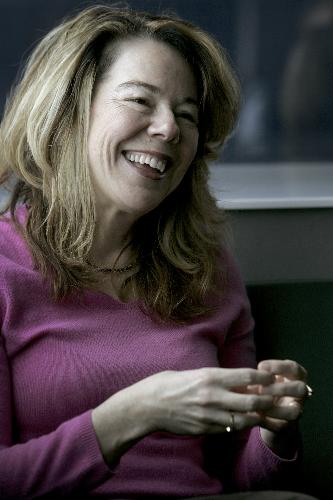Directors: Just Visiting
Actor Marc Halsey sat down with two acclaimed expat MN luminaries, coincidentally in the Twin Cities at the same time to helm two productions: Casey Stangl (THIRD for the Guthrie) and Larissa Kokernot (EURYDICE for Ten Thousand Things).


LARISSA KOKERNOT AND CASEY STANGL ARE BOTH LOS ANGELES-BASED directors and former colleagues who began their careers in the Twin Cities. Fifteen years after first meeting, they each returned almost simultaneously to the Twin Cities this winter: Stangl came back the Minneapolis to direct Wendy Wasserstein’s Third for the Guthrie, while Kokernot returned to direct Sarah Ruhls Eurydice for Ten Thousand Things.
Their friendship began with a phone call.
In 1993, Casey Stangls newly minted Twin Cities theater company Eye of the Storm was producing the play Baltimore Waltz by Paula Vogel. Larissa Kokernot had just returned home to Minneapolis after graduating from Brown University where Vogel was her instructor. Stangl remembers their first conversation: [Larissa] just called me and said, I love that play and is there anything I can do? I said, Well, you wanna run our box office?
Interested in female leadership, Kokernot quickly cultivated a friendship with Stangl (as well as Wendy Knox at Frank Theater). I basically just insinuated myself into their lives. Before long Kokernot was performing in Eye of the Storm productions and soon expressed interest in directing. At first, Kokernot’s degree of participation may have had as much to do simply with her proximity to the action and willingness to help as anything else. Anyone that walks in that is capable, you latch on to, says Stangl. But when Stangl saw a play Kokernot directed in the Minnesota Fringe Festival, she knew she had real vision. [Her show, a production of David Greenspan’s Jack] was so cool and sharp and fun, Stangl remembers, making sense of complicated text.
Kokernot soon joined Stangl as an assistant director for a show at History Theater, became an Artistic Associate at Eye of the Storm, and would later work with her on countless productions, including Blue/Orange at the Guthrie Lab.
This February, after years living away from Minnesota and within days of both their plays opening in the Twin Cities, the Stangl and Kokernot met up at a coffee shop in the warehouse district to talk about directing, each other, and their Minneapolis roots.
It was a huge piece of the puzzle for me in terms of my growth as an artist, says Kokernot of Eye of the Storm. She could act there in one show under Stangls direction, direct the next production herself, and, meanwhile, introduce new writers to the company.
It was a place where I could be all the people that I was artistically, Kokernot says.
Through hours in the rehearsal room together and a shared aesthetic about how to talk about the process, a relationship developed between the two directors. Rarely do directors have the benefit of constructive feedback from colleagues who have seen much of their work; even fewer have worked closely with peers in the rehearsal room, a space that can be vulnerable for even the most accomplished of directors. So, finding advice as a director or discussing ideas on a project can be tricky.
Its very easy to get feedback from someone, Stangl says, and what they end up doing is essentially telling you how they would direct it. They dont always mean to, but they do, because thats the language they have.
Stangl and Kokernot take an approach more typical of dramaturgy when offering director-to-director assistance, essentially asking: What is your play and how can we get to that? Its a relationship thats proved to be invaluable as theyve worked.
The Storms End
After a host of successful shows and a solid place in the Twin Cities theater scene, few suspected that Stangl and Kokernots artistic home at Eye of the Storm was nearing its final bow.
I basically got to a point where I started to feel like I was banging my head on the ceiling of what I could do here, says Stangl, who worked the equivalent of no less than four jobs at Eye of the Storm. She adds, A lot of it was about funding. She had started the company with an ambitious philosophical and practical goal: Funnel every dollar and dime into support of the artists and into promotion.
Stangl believes the decision to compensate artists more fully led to the success of the company. But she says it also ensured its end. If you dont figure out a way to build some infrastructure as you grow, youll crash and burn, she reflects. But a theater company closing its doors, she adds, might not necessarily be a bad thing. Theres nothing that says every theater company has to be around for fifty years.
Leaving Minneapolis
Stangl and Kokernot both felt they needed to broaden their directing opportunities. Stangl had a flourishing freelance career that included work at the Guthrie Theater and Minnesota Opera. But she wanted a bigger pool in which to work. And she had recently become interested in exploring television and film where she believes more and more of the best writing is happening.
I wanted a new frontier, a different way to tell the story, she says. And, also a bigger audience and potential for greater compensation. When her husband was offered a job in Los Angeles after a fact finding mission they took there together, things seemed to be falling into place.
For Kokernot, the move to LA was less intentional. She continued to act and direct but knew she wanted to focus solely on directing. She searched for a graduate program that would offer her, like Eye of the Storm had, a collaborative model where playwrights, directors, and designers all worked together on a larger scale. After three years studying directing at her top-choice school, University of California-San Diego, she and her husband moved to Los Angeles where he is a screenwriter.
Suddenly both women were sharing a city again, able to see each others work and make use of the valuable language they had first developed in Minneapolis.
Why LA?
Los Angeles has a reputation for many things. Amazing theater is not one of them. More often come reports of vanity productions, plays where actors are more interested in dressing for an agent in the audience than for the character theyre playing. Kokernot and Stangl found there is, in fact, a sense there that theater there is something artsy you do when not working in television and film.
But theres actually a lot of extremely good work, says Stangl. And a lot of interesting companies with people really dedicated to what theyre doing. So, its not a question of the quality or quantity of the work. The issue Stangl and Kokernot agree may be in how that theater is received.
Its not part of the cultural conversation [in L.A.] like it is here, says Kokernot, who grew up in Minneapolis. For me, theater has always been interesting, she says, when its not just theater people talking to theater people, but when it reaches out.
That may be what keeps these two directors coming back to Minneapolis. (Stangl directed Pygmalion at the Guthrie in 2004 and Kokernot directed Red Noses with Ten Thousand Things in 2006.)
Both are back in Los Angeles now and on to other directing projects.
With Stangl increasingly interested in directing for the screen and Kokernot considering a return to acting, they may find themselves working in different areas. The language with each other that theyve created, however, seems likely to translate no matter where they go.
About the writer: Marc Halsey is an actor and writer. He played Orpheus in Ten Thousand Things production of Eurydice and wrote Boy Cowboy for the upcoming Chicago Avenue Project.